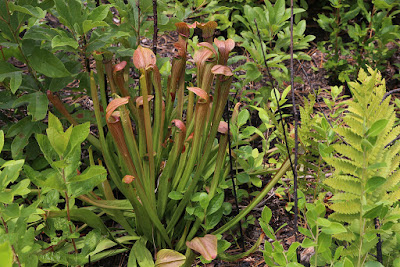Sweet pitcher plant is found from southern Mississippi, through southern Alabama, the Florida panhandle and Georgia, to the coastal plains of Virginia and South Carolina. It grows in bogs, seepy stream banks, wet savannas, Atlantic white cedar swamps, wet pine flat woods; powerlines and ditches through these habitats.
Sweet pitcher plant also called as Sarracenia rubra, Red pitcher plant, is a carnivorous plant of the genus Sarracenia. This species was described by Thomas Walter in 1788.
IDENTIFY SWEET PITCHER PLANT - SARRACENIA RUBRA
Sweet pitcher plant is found from southern Mississippi, through southern Alabama, the Florida panhandle and Georgia, to the coastal plains of Virginia and South Carolina. It grows in bogs, seepy stream banks, wet savannas, Atlantic white cedar swamps, wet pine flat woods; powerlines and ditches through these habitats.
Sarracenia rubra is a perennial herb with leaves modified into erect, tubular pitchers. The pitchers are 8 - 70 cm tall, several per plant, red or green with a network of red veins, only slightly widening from base to opening; a narrow wing runs the length of the pitcher and a red, pointed hood curves over the opening.
Red pitcher plant capture and digest insects and other small animals in their pitchers. Nectar is produced by glands around the top of the pitcher, luring animals to the opening with its sweet smell. Stiff, down-pointing hairs line the pitcher, encouraging the animals to slide in and impeding their escape. Enzymes dissolved in water in the base of the pitcher digest the animals, making nutrients, particularly nitrogen, available for absorption by the plant.
This species blooms April-May from 12 - 75 cm tall, leafless flower stalk. Flower with 5 drooping, dark red petals, 2.5 - 4 cm long; 5 green to maroon sepals, up to 1.8 - 2.7 cm long, held horizontally or curved backwards; a green, umbrella-shaped style disk in the center. Sepals and style disk persist on the plant long after the petals fall and after the fruit, a round, warty capsule up to 0.6 - 1.2 cm wide, develops.
Some varieties and clones: Sarracenia rubra subsp. rubra (fragrant flowers, the summer pitchers are narrow, strongly veined, with a short, pointed operculum, and reach a height of 30 to 45 cm.); Sarracenia rubra subsp. Jonesii (the pitchers are quite similar to those of Sarracenia rubra but with a noticeable bulge in their upper part, and can measure 60 cm high); Sarracenia rubra subsp. gulfensis (the large operculum ripples slightly, the flowers are not very fragrant.).
SWEET PITCHER PLANT - SARRACENIA RUBRA CARE AND CULTURE
Cultural information should only be used as a guide, and should be to be adapted to suit you. Your physical location; where you grow your plants, how much time you have to devote to their care, and many other factors, will need to be taken into account. Only then can you decide on the cultural methods that best suit you and your plants.
Light and temperature:
Sweet pitcher plant grow best in full sun, 6 or more hours of direct sunlight. In part shade, leaf coloring does not develop as it should and pitchers droop. The plant need the temperature of 5 to 15 ° C in winter , 20 to 30 ° C in summer . It can be installed in outdoor peat bogs because it can withstand the temperatures of -12 ° C.
Substrate, growing media and repotting:
Sarracenia rubra can be grown in pot using 70% blonde peat , 10% sand, 10% perlite, 10% vermiculite as substrate.
Watering:
Red pitcher plant need the humidity of between 40 and 70%. Use mineral-free water or water low in minerals. Keep the soil wet by setting the plant in a dish of standing water from spring to autumn. During winter rest, soil moisture is low.
Feeding:
Avoid fertilizers, regular garden soil, and compost. Kept outside, the plant will catch more than enough food for themselves. If you keep your plants indoors, you can feed them with dried insects every few weeks.
Propagation:
Sweet pitcher plant can be propagated by seeds or division. Plants may be grown from seed with effort, but will not flower for the first 4-5 years. Easiest propagation is by rhizome division.















COMMENTS